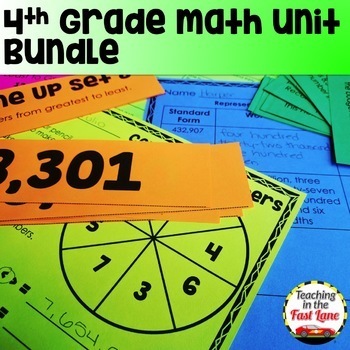4th Grade Math Bundle - Lesson Plans, Activities, and More for 4th Grade Math!
- Zip
Products in this Bundle (17)
showing 1-5 of 17 products
Also included in
- This 4th Grade Math Bundle includes unit lesson plans, math stations, and Digital Stinky Feet review games for every unit of the year! TEKS and CCSS aligned this bundle will have your students begging you for more while saving you time! ---------------------------------------------------------------Price $214.95Original Price $339.84Save $124.89
Description
Are your 4th grade math plans feeling stale? Check out this bundle with activities to engage your 4th grade math students with rigorous lessons and activities.
-------------------------------------------------------
This bundle of 4th-grade math units with lesson plans is a great way to use a guided math approach in the 4th-grade classroom.
This bundle can be used alone or to supplement other classroom materials.
These units are designed to follow the TEKS and CCSS.
Each unit in this 4th grade math bundle includes:
- a pre-assessment
- content vocabulary
- daily warm-ups
- exit tickets
- daily lessons and activities
- a post-assessment.
-------------------------------------------------------
⬆️ Check out the preview above for a better look at what is included in the 4th grade math bundle! ⬆️
-------------------------------------------------------
4th Grade Math Bundle Units Include:
- Place Value
- identifying and naming whole numbers to a billion, forms of a number, as well as comparing and ordering numbers
- Decimals
- identifying and naming decimals to the hundredths place as well as comparing and ordering decimals
- Fractions Unit
- identifying fractions, composing and decomposing fractions, comparing fractions, and generating equivalent fractions
- Adding and Subtracting Fractions with Like Denominators Unit
- represent and solve addition and subtraction of fractions with equal denominators using objects and pictorial models that build to the number line and properties of operations
- Addition and Subtraction of Whole Numbers and Decimals Unit
- add and subtract whole numbers and decimals to the hundredths place using the standard algorithm
- Multiplication Unit
- use strategies and algorithms, including the standard algorithm, to multiply up to a four-digit number by a one-digit number and to multiply a two-digit number by a two-digit number. Strategies may include mental math, partial products, and the commutative, associative, and distributive properties
- Division Unit
- represent the quotient of up to a four-digit whole number divided by a one-digit whole number using arrays, area models, or equations
- Equations and Models for Solving Unit
- represent multi-step problems involving the four operations with whole numbers using strip diagrams and equations with a letter standing for the unknown quantity
- Multi-Step Problem Solving Unit
- solve with fluency one- and two-step problems involving addition, subtraction, multiplication, and division, including interpreting remainders
- Numerical Patterns and Paired Number Tables Unit
- represent problems using an input-output table and numerical expressions to generate a number pattern that follows a given rule representing the relationship of the values in the resulting sequence and their position in the sequence
- Perimeter and Area Unit
- solve problems related to perimeter and area of rectangles where dimensions are whole numbers
- Geometry Unit
- identify points, lines, line segments, rays, angles, and perpendicular and parallel lines; identify and draw one or more lines of symmetry, if they exist, for a two-dimensional figure; apply knowledge of right angles to identify acute, right, and obtuse triangles; and classify two-dimensional figures based on the presence or absence of parallel or perpendicular lines or the presence or absence of angles of a specified size
- Measuring Angles Unit
- determine the approximate measures of angles in degrees to the nearest whole number using a protractor; draw an angle with a given measure; and determine the measure of an unknown angle formed by two non-overlapping adjacent angles given one or both angle measures
- Measurement Unit
- identify relative sizes of measurement units within the customary and metric systems; convert measurements within the same measurement system, customary or metric, from a smaller unit into a larger unit or a larger unit into a smaller unit when given other equivalent measures represented in a table; and solve problems that deal with measurements of length, intervals of time, liquid volumes, mass, and money using addition, subtraction, multiplication, or division as appropriate.
- Data and Graphs Unit
- represent data on a frequency table, dot plot, or stem-and-leaf plot marked with whole numbers and fractions; and solve one- and two-step problems using data in whole number, decimal, and fraction form in a frequency table, dot plot, or stem-and-leaf plot.
- Financial Literacy Unit
- distinguish between fixed and variable expenses; calculate profit in a given situation; compare the advantages and disadvantages of various savings options; describe how to allocate a weekly allowance among spending; saving, including for college; and sharing; and describe the basic purpose of financial institutions, including keeping money safe, borrowing money, and lending
- Review Unit
- a review of all the standards included in the previous units
-------------------------------------------------------
These units are designed to be paired with these Math Stations for an organized and engaging math block following the guided math model.
-------------------------------------------------------
What Are Teachers Saying About This 4th Grade Math Bundle?
⭐️⭐️⭐️⭐️⭐️
This resource is teacher GOLD! Thank you so much for helping me organize my classroom. I love that it coordinates with Texas TEKS!
-Christina B.
⭐️⭐️⭐️⭐️⭐️
Thank you!!! I use these every day. They are perfect for teachers new to the subject of math. Worth every penny!
-Kelcee B.
⭐️⭐️⭐️⭐️⭐️
I love using this resource as the product is very thorough. It is a great addition to my math block. I like the lesson plans as it makes it easy to implement. The reassessment gives me an idea of how to differentiate.
-Teresa G.






